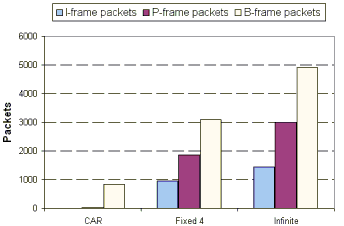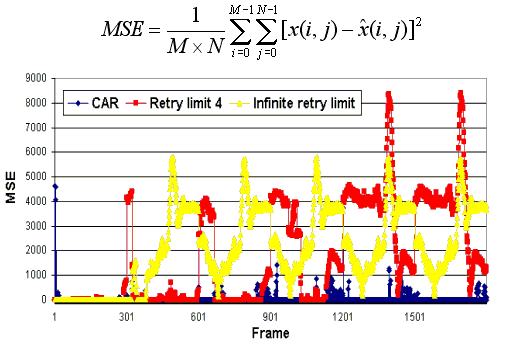 |
About AMP Lab Projects Downloads Publications People Links
Project - Content-aware Adaptive Retry for Video Streaming on 802.11 WLANs
| Motivation and Goal |
Robust video streaming over vibrant wireless LAN (WLAN) poses many challenges. In order to maximize channel throughput, rate adaptation (RA) to dynamically select the transmission rate at a given time has been recognized as an effective way to improve the performance of 802.11 WLANs. However, extra retransmission for channel probing during RA also causes additional delay and possible packet loss. For video streaming, we believe this overhead should be placed on less important packets so as to minimize quality distortion on the receiver side. In this project, we propose a content-aware adaptive retry (CAR) mechanism for video streaming over 802.11 WLANs, where retry decision is made dynamically according to packet importance and its play-out schedule. Simulation results show that the proposed mechanism significantly improves video quality as well as saves transmission bandwidth.
Content-aware Adaptive Retry (CAR)
We introduce a new retransmission algorithm called content-aware adaptive retry (CAR) for wireless video streaming over 802.11 WLAN MAC layer. Instead of maintaining a "count-based" retry limit, we set a "time-based" retransmission deadline for each packet according to the coded video properties. By doing so, we account for the deference incurred from 802.11 random backoff deference as well as co-channel interference, and determine to issue an retransmission or drop a packet accordingly. This strategy also avoid sending outdated packets which will inevitably discarded at the receiver, and therefore save channel bandwidth. As show in figure 1, the (re-)transmission time period of an I-frame packet is further extended to the retransmission time period of its subsequent P- or B-frame packets within the same GOP. Similarly, the retransmission time period of a P-frame packet is extended in the same manner. By adopting this adaptive retransmission mechanism, we reserve more channel resource for more important packets with an intention to increase user-perceived video quality.

Figure 1: CAR Archeticture
Figure 2 shows the flow chart of the proposed CAR algorithm:

Figure 2: Flow Chart of CAR
Computer simulation is used to evaluate the performance of the proposed algorithm. Figure 3 shows the simulation scenario used with OPNET 10.5.A.

Figure 3: Simulation Scenario
Figure 4 demonstrates
the plot of ahead of schedule time with, (1) the proposed CAR
mechanism with Auto Rate Fallback (ARF) RA algorithm enabled, (2) with a fixed
finite retry limit configuration with ARF enabled, (3) with finite retry
limit configuration with ARF. A negative value of ahead of schedule time means an outdated packet
which will be discarded on the receiver side. The simulation result shows that
CAR outperforms the others in terms of up-to-date packets. With 500 ms (a GOP
period) initial
delay, all the packets are arrived on schedule in the CAR scenario.

Figure 4: Result of ahead of schedule packets
Figure 5 compares the number of packet loss in terms of frame type. From the figure, we see that CAR has the least packet loss. Moreover, we have no I-frame packet loss and quite low P frame packet loss.

Figure 5: Comparison of Packet loss
Figure 6 shows the Mean Square Error (MSE) of the Y component. The figure shows that CAR can maintain a relative low MSE for the whole simulation period

Figure 6: Mean Square Error (MSE) of the Y Component
The CAR algorithm adopts the characteristics of error propagation in coded video stream to maximum the video quality on the receiver side. It also considers the playback schedule of each packet to avoid unnecessary transmission so as to save channel bandwidth. Simulation results show that CAR with ARF outperforms the conventional fixed retry limit mechanism significantly in terms of packet loss, channel utilization, and user-perceived video quality.
- M. Lu, P. Steenkiste, and T. Chen, "Video Streaming Over 802.11 WLANs With Content-Aware Adaptive Retry," submitted to IEEE International Conference on Multimedia and Expo, July 2005.
Any suggestions or comments are welcome. Please send them to Amy, Mei-Hsuan Lu.